5 Common Amish Church Practices (Uncommon In Other Churches)
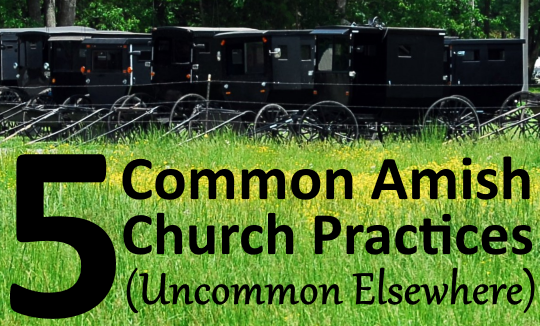
What are some characteristic Amish church practices? Amish do a number of things which make them different from most other Christian churches.
Here are five religious customs common to the Amish, which you won’t see much of elsewhere.
Five Common Amish Church Practices (Uncommon Elsewhere)
1. Home Worship
With the exception of a very small minority (here is one example), Old Order Amish do not build churches or meetinghouses. Rather they use a structure at the homes of their members–a workshop, basement, barn.
A large horse-drawn wagon brings collapsible wooden benches from home to home, which are set up in whatever area church is being held, along with songbooks. In many cases the benches later double as tables for the fellowship meal. It’s about as simple and practical a setup as you could come up with.

Church service rotates throughout the community so that each household will hold service about once per year. In some cases if a home doesn’t have large enough facilities to accommodate the congregation, church may be held at another nearby home instead.
The practice of home worship is less costly, and more importantly, places the focus on the members and not the building as the “church.”
2. Unpaid Ministers Who Don’t Seek the Position
Amish ministers do not draw a salary for their service. They have to study and prepare to preach on their own time, and deal with other church matters on their own time. They are supported and respected in their communities, but aren’t otherwise financially compensated.
They also don’t follow a calling to leadership in the church. They don’t enter divinity school or go through years of seminary training with the goal of becoming a church leader. From the way Amish talk about it, few wish for the position, which is generally considered a burden (though hopefully they also find it a blessing).
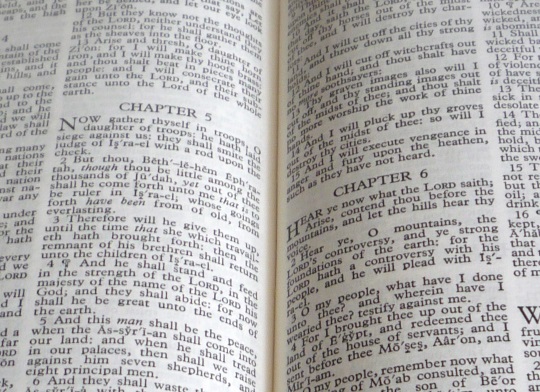
Rather, they are selected in a process outsiders might view as partially a congregational choice, and partially by chance. Baptized male individuals are nominated by other baptized (male and female) members. Being nominated is not unexpected, as it’s something all males agree to at baptism.
Each nominated man selects a hymnbook from a collection, one of which contains a slip of paper on which is written a Bible verse, indicating the new minister. This part of the process may seem random, but Amish feel this is where the hand of God enters the picture.
3. The Holy Kiss
Amish ministers and in some cases lay members greet one another with the holy kiss. It’s a kiss of fellowship on the lips, given from male to male and female to female. Amish feel this practice is mandated in various places in Scripture, including I Corinthians 16:20, I Thessalonians 5:26, and I Peter 5:14.
As one Amish publication explains, the holy kiss “is a token of love and fellowship with one another and with the Lord. It is to be practiced regularly by all Christians as they meet and fellowship together, as a brotherhood.”
Furthermore, “the holy kiss is a mere form of greeting if the participant does not walk in true holiness and righteousness, loving one another with a pure heart fervently.”
The holy kiss is also given by the bishop and/or his wife as a welcome to newly baptized church members.
4. Social Shunning
Social shunning is one of the most controversial religious customs of the Amish. It is the practice of church discipline, which takes the form of changed social behavior towards an excommunicated individual.
It can include not doing business with an excommunicated person and altered eating arrangements (not eating together with members in good standing, at least in certain situations). It is a reminder of the changed relationship and done in hope that the wayward member will return to good standing in the church.
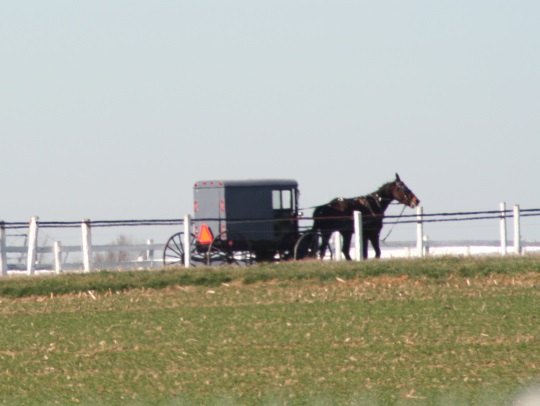
Amish feel that shunning excommunicated members is a Biblically-mandated duty. That’s not to say that Amish people relish the idea.
It is typical that both lay members and ministry attempt to convince a member who has violated church rules to change their behavior, before a vote for excommunication is taken. As one Amishman put it, “shunning is usually done with great reluctance and only once there is nothing else left to do.” He elaborates:
Shunning is never pleasant business both for the church and for the shunned individual and it would be easiest and most convenient to not practice it.
But feeling bound to the Scripture and knowing of no better way other than to try and use Christian Discretion and moderation, the practice continues in varying degrees. Some almost totally ignore it, especially in private settings, while others are more rigorous. It is important to remember there is no sacramental value on the ban to the point a banned one is considered as going to hell. The Lord is still the final judge.
Different churches practice shunning differently, with some following a stricter form of shunning which requires confession and reinstatement in the home congregation to be lifted. Others will cease the practice after a period if a member joins a related, though not necessarily Amish, church.
Shunning was a key issue in the 1693 division involving founder Jakob Ammann which led to the creation of the Amish, and it continues in its different forms as a fundamental practice of the church.
5. Song Without Music
Amish church singing is unaccompanied by instruments. It is an unusual voice-only style with long, drawn-out notes. It’s not really melodic or “catchy.” You don’t have solo voices exhibiting their talent above all the rest.
The closest you get to that are the solo notes of the Vorsinger (song leader) who begins each line of a hymn, before the rest of the congregation crashes in a few seconds later.
While Amish people may sing in different styles elsewhere, they feel communal, unaccompanied singing is better for church. It doesn’t elevate any individual’s instrumental or vocal talent above the rest.
That in turn discourages pride and reflects the unity of the congregation. It also carries on a tradition of song which has lasted centuries. You can hear an example of church singing in the clip below:
What other Amish religious practices are unusual or uncommon elsewhere?
Image credits: church buggies- sniegowski/flickr; open Bible- revger/flickr; Single buggy- Ed C.





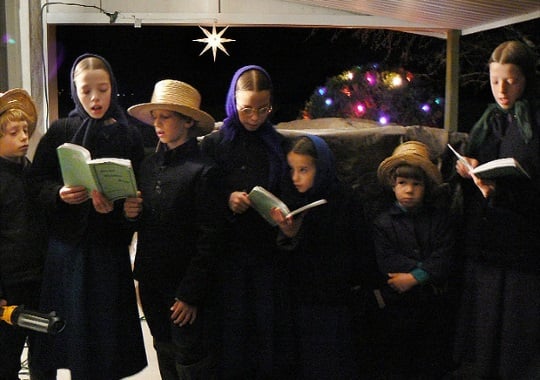

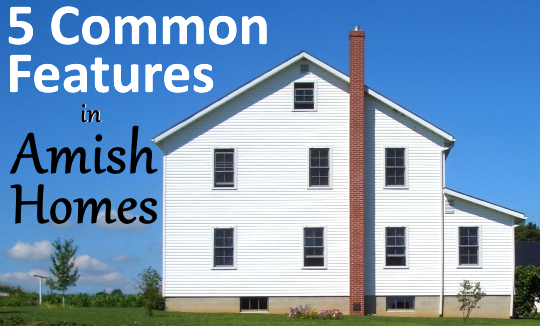
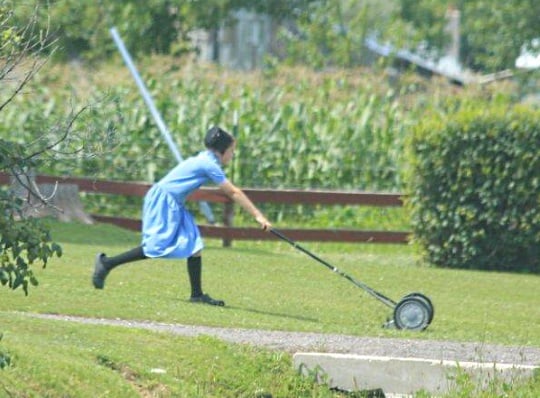

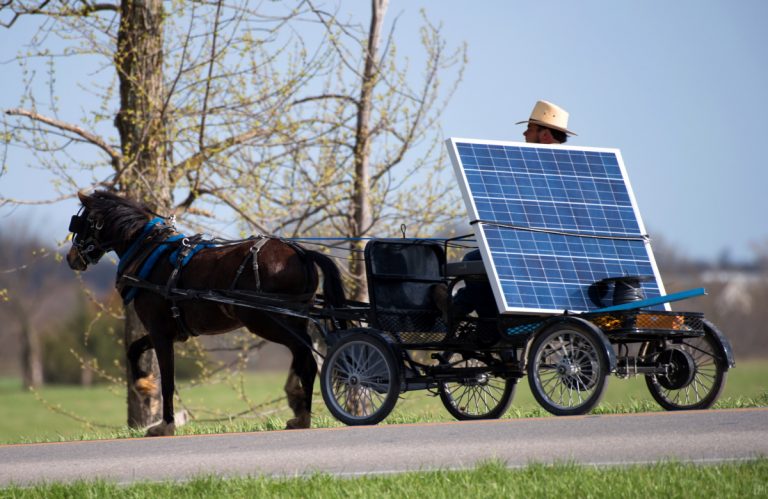
Ministers
I understand how they pick their Ministers but my question is if they don’t got to school for it, are they ordained? And are the Legal to Marry people?
Ordained?
Not all Christian denominations require schooling and you can go online, pay a fee and be ordained. Many non denominational pastors have no seminary education. And yes, they can marry people.
Debbie H
I understand that not all go to seminary school or even have to.. that isn’t what I was referring to. But you still have to have some type or certificate to be able to marry people, to baptize someone, and to do funerals.. They can’t go online to do that. I was just wondering how they are legal to do it.
There is no law that says you have to have a certificate to baptize.
On the question of being legal to officiate in marriages and funerals, only bishops do that and they get a license from the county. So Amish bishops are first ordained as a minister and might later be ordained as a bishop and then gets licensed.
Amish-Girl Rebecca
Thank you,, your comment on my question was the answer I was looking for.. I appreciate the information.
Have a great day.
Robin Wyatt
Another interesting practice is that when church begins there is a distinct progression of who enters the church space first, second and last, and in larger districts or smaller homes, who stands and who sits.
This true here in our community. The oldest man first and so on. If you are 12 and older and a male, you join your father. If younger you stay with your mother.
In our community the married women and the little ones are seated in age before the men come in usually with the older ladies in front. Then the ministers come in and shake hands with the women , followed by the other men who follow by age with the younger men also having children along. Then the unmarried girls sit down behind the ministers who are facing the other men. last the boys come in and sit behind the men. Children up to 9 or 10 sit with either of their parents and may go back and forth between them during the day or may sit with grandparents or older siblings.
uncommon
The list for uncommon could tend to be lengthy as far as traditions are concerned. From the way you enter church to how, who and when one gets to eat to who or what they’ve done to come under the “beans” or ban as it’s refered to here. We live in a very small community in PA. This community originates from the Dover Delaware Amish. My husband’s grandfather stated this community! It’s been very interesting and sometimes confusing to understand even outside of church regulations. I have a few embarrassing memories that were awful at the time but are funny now! BTW.. Amish women do NOT “high five”..normally. What a wonderful site Erik!
Thank you Beckysue! I think you’re right, you could probably add a number of other things to this list.
I haven’t looked too far into it, but I would be curious how many other Christian churches today practice footwashing, sex-segregated seating, have 3-4 hour long services, or service on alternating Sundays to name a few.
Interesting to hear about your husband’s grandfather starting Dover, was he a Miller?
That would be interesting! I meant that his grandfather started the community here in PA. They are Masts. The majority here are Masts and Millers along with a few Girods, Yoders, and Nissleys.
Thanks Beckysue–yes I was referring to the Dover community, but after I wrote that I realized you may have been referring to the PA community.
I think it is refreshing that in this day and age some churches look like a city in the fact that they are huge. This just proves you can worship anywhere and make do with what you have. They use their homes. Simple and plain just like them. This is what amazes me is the focus of the Amish on what is important in life! Boy could we learn some lessons from them!!!!
Of course, establishing the ordnung and the associated meeting for doing so is something only found in certain anabaptist churches.
Communion services are common to all Christianity, but how the Amish go about it extremely different. Before the Amish can have communion, the church members have to be in full agreement, or in biblical language, of ‘one accord’. This process involves the deacon approaching each member to see if he/she is in good standing with the church and all other members. If no one is on objection, the church comes together to discuss the ordnung and if all are still in agreement, a communion service will be held the following service. If there are issues, the church will attempt a few times to iron them out, but communion cannot be held until then. After a meeting or two, if nothing comes together, communion is skipped and the congregation will wait another 6 months to try again. That is all in stark contrast to the main line churches that leave the communion decision up to the individual.
Born and raised (and schooled for 12 years) a Catholic (though not practicing now), I had no idea that my opinion that babies should not be baptized, only older teens or adults should decide if/when to join a church, was pretty much what Anabaptists (including the Amish) believed. I knew virtually nothing about the Amish back then, but when I started learning about Amish beliefs, I found I had more in common with them than I thought(reliogiously speaking).
Also, when in (Catholic) high school in the 1960’s, the young priest who taught our Senior class religious education, the “new” worship (aside from guitar masses, no longer having to wear a “head covering” in church if you were a woman)that was being talked about was HOME services (Mass) which was what the early Christians practiced. Another similarity with the Amish, although it didn’t come to happen large-scale (in the Catholic religion) that I was ever aware of…I left the church shortly thereafter.
As far as marriage, baptism or funerals go, as Debbie H. mentions, you can go online and legally be ordained to marry people. As far as I know, you don’t “need” to be ordained to perform a baptism (it would vary with various religious denominations, of course.) We were taught that we, as baptized Catholics, in the event of a non-baptized child or a willing teen/adult being at immediate risk of death, wanted to be baptized, we (non-ordained Catholic males & females) could baptize that child/person ourselves, and it would “count”, at least in the eyes of the Catholic church (I have no idea what other denominations can do). As far as funerals go, you don’t need any kind of license or ordination certificate (that I know of) to “do” a funeral service. I’ve been to funerals where the funeral director did the service, or friends or family of the deceased ran the ceremony. Now, I’m not talking about giving “religious” last rights (back in the ’60’s it was still called “Extreme Unction”, a Catholic sacrament.) My guess is it all depends on one’s religious beliefs, rules & official church regulations, that dictates what the priest, minister, ordinary person can “officially” do, but that would only be in a religious context. Hundreds of thousands of people are married (legally) each year by non-ordained judges, justices of the peace, internet-ordained regular people…and non-denominational “leaders”.
I was under the impression that what made it(marriage) legal was that the bride and groom THEMSELVES were agreeing (contracting) to be married. The priest or judge and others (usually at least 2) in attendance were merely witnesses to the event (as others may also need to witness the signing of a will or other legal document.)
“Render unto Caesar…”
Interesting…the singing, especially the Vorsinger (who seems to have a talent for song). Beautifully done video…quite peaceful. Wouldn’t mind visiting!
Alice Mary
Well said Alice Mary. I don’t think John the Baptist or any disciple had a certificate to Baptize. It is just modern day legalities of religious organizations and government that require certifications. God ordained is what is important. That is why organized religion if dying and non denominational is growing.
Another interesting fact: A recent Pew Survey shows that the fastest dying religion in the US is Christianity and the fastest growing is Muslim. Of course the Amish is one Christian religion that has continually grown.
home church
What is not mentioned in this article is the preparation to the before church. Many women from the family or even the congregation gather at the person’s house who is hosting the service and clean it from top to bottom. I was blessed to have my
Swiss-Amish friend and her daughter (5 years old) come to clean my house as we were expecting out of town guests. She kept telling me “I always do (such-n-such) when I help clean someone’s house before church.” Let me tell you, when she was done you could eat off of my floors.
Sounds like you have a great friend Samantha 🙂 Thanks for bringing up this aspect of church. We have a post on that and there is a pretty good article linked within it, describing how families prepare in a Swartzentruber Amish community:
https://amishamerica.com/how-do-amish-prepare-their-homes-for-church/
Numbers 2,3, and 5 are the same in our (conservative Mennonite) church, pretty much
That’s interesting to know. I assumed there would be some overlap with the plainer Mennonite churches. On minister selection, I’m curious how similar it looks in your church as far as nomination, and the “at random” selection of one from the lot?
Nominations for ministers and deacons is the same as you have described for Amish. It IS possible for a man to decline, but that seems kind of the rare exception, and there has to be a pressing reason. We put a slip of paper in a Bible, and there are as many Bibles as men in the lot. The lot falls on whoever picks the Bible with the paper in it.
Our deacons also are expected to be able to preach if a minister is unexpectedly absent. Doesn’t happen often, but it can happen.
Thanks, Forest. Very interesting.
Amish Church
I was never at a Amish Church service but I always heard the older men enter first and sit on one side then the women come in with the younger ones.
Eric In all your travels in Lancaster CO do you know of any Amish
who host a Amish meal in their home. As we would like to go there sometime Please let me know
email me at lazybones7@verizon.net
Amish Church
These are two of my favorite churches in the Lancaster area that are not in private homes. It shouldn’t be too difficult to get a lunch invitation in either church if you introduce yourself and ask if anyone is hosting a lunch. Both churches are seated with women on left and men on right when entering.
West Haven Amish Mennonite Church
837 Peters Rd
New Holland, PA 17557
Spring Garden Amish Mennonite Church
5157 Old Philadelphia Pike
Kinzers, PA 17535
Singing
Many Church of Christ groups sing unaccompanied–but not necessarily in unison.
Church
When looking back on the history of the Methodist church, at one time in some congregations, the men sat on the left and women the right. The church I grew up in didn’t have that arrangement. But a rural church that we attended after we were married in 1982, did at one time. That took me completely by surprise as I’d never heard of such a thing! This all took place in WI, just different sides of the state.
Looking back in Lutheran history you will find that they also were segregated. I’ll have to call an old Lutheran from my home town and ask if they sat on different sides. When we visited Norway we were inside a stave church, and in the “olden days” the men and women came in separate doors.
I Googled the question and if you have some time to kill and a pot of coffee, you’re going to be reading for quite some time! lol
I found this passage in my reading;
Galatians 3:28
There is neither Jew nor Greek, there is neither slave nor free, and there is neither male nor female, for you are all one in Christ Jesus.
When I think back on our days in church with four kids, I have to wonder how the sitting arrangement on different sides would have worked!
Mom, Ok that’s it, you’re going to sit with your father!
Dad, No, keep him over there!
The “him” would have been our #2 child!
Grace and blessings, Terry
PS: Erik, once again I didn’t mean to write a book! 😉
Not a problem Terry! Thanks for the Methodist example. With the Amish below a certain age you will see younger girls with their dad on the men’s side for example.
Hi Terry, regarding separate seating here is a verse you may like.
Mat 22:30 For in the resurrection they neither marry, nor are given in marriage, but are as the angels of God in heaven.
Thus church members being those who expect to be resurrected, when they meet for worship, sit separately as brothers and sisters in the Lord and not together as husbands and wives in the flesh.
Thereby symbolizing our future heavenly state and not our current worldly state.
Hi Dirk
This is when a Bible study provides us with an entirely new meaning to scripture. I’m often nosing around in Matthew, but this was all new to me. I have a Bible scholar at church and we’ll have coffee and chew on the passage! AS disciples of Christ we are NEVER done learning!
In Christian love
Evangelical and Reformed Church in Central Illinois observed “men on one side and women on the other” seating for several years.
Thanks Carol and VT for the additional examples.
2,3,5 also similar in the Apostolic Christian Church.
The Apostolic Christian Church of America is also similar to number 4 as well. However we do not call it shunning. It is know as the Ban or discipline. The degree of discipline depends upon the degree of the offense/sin.
Symbolic footwashing is still practiced in the (Roman) Catholic Church during Holy Week–whoever is presiding over the Mass (priest, bishop, or Pope) will wash the feet of pre-selected people. These people are usually members of the congregation, but the Pope in recent years has also chosen to make larger statements by washing the feet of imprisoned Muslim women, for example, which has NOT been the usual way of things. As to #1-5, no; none of those are features of the RC Church.
5 Common Amish Church Practices
Terry, I got a big smile when you referred to shoving child #2 to each other. The men have the children a lot and tend to have less fuss in most cases, due to the old and still active concept of behaving when Dad speaks, and in all honesty, Dads take less toys along. My children would fall asleep easier with hubby, when 1-2 year olds. But the moms have the babies who breastfeed, and are well..babies.
Now this next one is for Erik! Hey you, when did you have a recorder in your pocket? In Topeka?? LOL They are doing a good djob of it! What do you think it sound slike in Heaven when we have hundreds of churches singing the same song (we all sing this Lob Leid as our 2nd song)at 9:30 AM on Sun morning?
Mary Alice good question, no not in Topeka, actually I did not record this song–someone else did, I just found it on YouTube, someone must have had a recorder somewhere. If I had wanted to record I would have sought your permission first 🙂
I have a question for you too because I know you travel to different communities, have you noticed differences in the way Lob Lied is sung in different places?
And thanks for giving us a little insight into how Dads manage to keep the children under control 🙂
5 Common Amish Church Practices
Erik,
Different communities have different accents, so that will make the wording (accented) vary from state to state, but the tune is pretty much same, so much so that a person can lead the song from another settlement very easily. It seems the beginning and ending in each line stays same.
That recording you have is like one sung at Menno Hoff, and it might have been recorded with some ex-Amish, not sure though.
And I knew you didn’t record it in Topeka.
Thanks Mary Alice, I was wondering if you might be able to tell where this song may have originated by detecting something in an accent. No idea how easy or difficult that might be when listening to church song (picking up accents in speech seems like it would be easier).
Similarity in some Orthodox
We have visited many Orthodox Christian Churches- Most practice 3 (Holy Kiss) and 5 (songs without instruments).
The Russian Orthodox Church we visited have men on one side, women on the other. The services are about 2.5 hours, women are covered (but not uniform coverings, just some type of scarf).
Infant baptism mentioned, was apparently from what I read from early church writings, started by the Apostles but they ‘didn’t write it down’ in the Scriptures- but there are 5 passages in New Testament that state whole households were baptized at the same time, which may have included the infants. They didn’t leave the infant out of membership of the Church, which one became a member at their baptism. Apparently infant baptism was the norm until it was contested by some new denominations (example Anabaptists) during the Reformation era- but until then it was practiced worldwide. Some denominations out of the Reformation continued to baptize infants (example Lutherans). I have recently understood all this differently from studying church history.
It was said here Muslim #’s are fastest growing in America- many are being evangelized to Islam in prison!
Amish are growing, mainly due to large families not by evangelizing or converts. It is interesting, that denominations that came from the Reformation era which wanted to be ‘scripture only’ started their own traditions- history repeats itself!
Common Amish church practices
Perhaps another Amish church practice would be the common meal after the service with the same foods served each time. I know most, if not all Christian churches have potlucks or fellowship dinners occasionally, but I am unaware of any that have a communal meal after every service with the same foods served.
same food
Well, that would be one less thing to stress about being the hostess!
“That’s what I made last time–everybody will think that’s the only thing I know how to make!”
Similarities
I am in southern Ohio, and there is a fair-sized Mennonite community nearby. I know that they also are segregated in their church service (held in a church building), as I once interrupted a service. I was having a personal crisis, and was driving to a family member’s house when I passed their church. My car turned in without me being entirely in control, at least mentally, and I just barged in, knowing my friend would be there. She immediately jumped out of her seat and came to me, taking me into a side room to talk. I felt embarrassed about it later, but not because anyone there made me feel so. At any rate, I noticed as I walked in that they were segregated.
The singing is reminiscent of the singing in the synagogue. The style of song, the melody, sounds very “Jewish,” if you will. Much like the Sh’ma. Here is the Sh’ma sung by a single voice, but in synagogue, many voices sing in unison. Lovely!
https://www.youtube.com/watch?v=QiJk9tf4jZU
In a number ways, the Jewish religion is similar to the Amish religion. Both emphasize living in compliance to local regulations. Both place a high value on the spiritual health of the community, whereas Christianity seems more concerned with the individual only. Many Jewish set themselves apart by their clothing (obviously the yarmulke, but also many women follow laws of tznius, or modesty, including covering the collarbone and the arm to the elbow) and other means (Orthodox Jews do not hug, shake hands, etc. with members of the opposite gender outside of family.) I have often noted the similarities between the two, and now I have the music as another commonality.
Another similarity
Synagogues also often meet after service on Shabbat for a light meal, called the oneg. That is a very good tradition, I think!
Mormons vs Amish
There are a lot of differences between the Mormons and Amish. The Mormons all sit together in a church. The Bishopric is not paid, they all hold regular jobs. The Bishop or his 2 councilors do no preaching. Members of the Ward (an area of the community) are asked to give talks. They have Sunday School, Relief Society for the women and Preisthood for the men. That is the only time that women and men are separated. Then they have the Sacrament meeting where everyone gets together. Usually families all sit together, but you can also see teens sitting with their friends. The Bishop and his 2 councilors sit in the front of the chapel facing the members. Members do the prayers and talks. In giving the sacrament,the Deacons aged 12-14, Teachers 14-16 the Priests aged 16-18, any of these can bless and pass the Sacrament given every Sunday. The first Sunday of the month, usually the Elders, aged 18- till they can’t walk any more, bless and pass the sacrament.
On baptisms, children do not get baptized before the age of 8. Once they turn 8, they meet with the Bishop who interviews them and then gives them a recommend. The same goes for people investigating the church, but they are taught discussions by the missionaries and are baptized by them. When the boys become Deacons, Teachers, Priests and Elders, they are also interviewed and if found worthy then they are ordained to that position. The Priests and Elders do the baptizing, give blessings by the laying on of hands.
When Bishops are called, it is done by the Stake Presidency. The Stake Presidency is over about 5 wards. They do fasting and praying to see who God wants for the callings. Once they have been called, it is announced in church and the members raise their hands if the agree and then there is the chance if the disagree, which usually does not happen. A Bishop usually holds this office for 5 years. He picks his councilors by praying and fasting. The person picked can refuse to take the position with no problems.
There are Ward, Stake and General Conferences though out the year. General Conference being the first weekend in April and October and it is watched on TV in your home. There are 2 sessions on Saturday and 2 on Sunday.
There are no Ward meals after church and the only time there is a ward get together is at Christmas and the ladies are assigned on what to bring.
The Bishop is the one that usually does weddings, unless the couple gets married in a temple, then it is some one who is ordained, such as the temple president, a bishop, councilor. In the temples, is the only place where women sit on the left side and men on the right, and special clothing is worn during the temple ceremony.
During a funeral, the Bishop presides and the family and close friends will give talks, a musical number or two. Then at the cemetery, an Elder in the family will say a blessing over the grave. Then family and friends will go back to the church for a meal.
I used to belong to the Mormon church, but I had my name removed back in 2007. If anyone has questions feel free to ask and I will answer them. There is more that I could put, but I feel like I’ve already written a book.
Shunning
Shunning is a biblical command as found in 1 Cor 5:11. This of course is for a Christian that is living in overt sin and refuses to listen to biblical teachings.
I have had several business and personal dealings with the Amish and have nothing but the utmost respect and admiration for them.
Pilgrim Holiness, Church of the Brethren
I was dedicated at three weeks old in the Pilgrim Holiness Church. The practices there were pretty well aligned with the Mennonite teaching, I believe. We had a pump organ played by one of the Pastor’s daughters and it was only one room with a privy out back. We had different corners of the church and center row of pews designated for Sunday School classes. I still remember kneeling facing the back of the pew for prayers. Families sat together with Elders leading the service and the Pastor delivered the sermon. Back in those days (1960s) females wore dresses and men wore suits in church. Women wore hats or hairnets in place of prayer kapps.
When I moved to Virginia, I was baptized (at 46yo) into the Church of the Brethren (I was raised by my Brethren grandfather; my grandmother was Pilgrim Holiness). Before I moved back to the Delmarva Peninsula, we still had wooden pews, sang from hymnals and was accompanied by a single piano or organ. I went back to visit several years ago and was dismayed to find that the church had turned into a modern day disappointment to me. Gone were the wooden pews, gone were the hymnals and even the choir section had been removed. I haven’t been back but still email the Pastor who was a fellow school teacher then and now a full-time Pastor. One day I may ask him, “What Happened!?”
The Church of the Brethren Church I am now attending only the Pastor’s wife and myself wear prayer kapps and very few women wear dresses. Families sit together and the choir pews are empty. I miss the “fire and brimstone” of the Holiness Church and truly dislike the way churches are turning to words on the wall with no musical notes, praise and worship teams where they seem to go on and on and on with you unable to keep up with singing just to please the few that wouldn’t walk in the door otherwise. Please don’t get me wrong, I’m grateful when new people show up and decide to stay, but am I the only one that feels churches are becoming too party-happy and not enough spiritualistic any more?
When I attend church I go to Praise God and His Son Jesus Christ, I don’t go to sit and be entertained. Not that it should be so solemn that you can hear a pin drop, I mean shouldn’t you respect the reason you attend in the first place? Yes, a “…joyful noise unto the Lord…” is wonderful, I love to sing, but is it necessary to have huge speakers blaring? Cricks in your neck from trying to follow words so high on the wall they might as well be on the ceiling? (laughing out loud). What happened to good ol’-fashioned Bible Study? The more I look back on my ancestor’s roots in church traditions, I wish we could add some of them back into the curriculum. Maybe slip in an old hymn that has stood for generations, have a special day where only girls are challenged to wear dresses, boys wear trousers and a shirt with buttons. Women’s turn to dress plainly, then men where trousers and a shirt that has buttons. I know that in today’s world there are people that cannot afford buttoned down shirts, etc. I do most of my clothes shopping at Goodwill, Salvation Army and local Christian Thrift stores. You have to look but decent clothing can be found. I, myself, have always dressed mostly plain all my life, but that’s my choice and do not look down my nose at what others wear, though I do shake my head a lot when I see the choices people do make of wearing pajamas in public, etc.
Ren I think you make a good point that in the supposed interest of attracting and retaining more congregants, churches may be throwing out things that are in fact what people need and counterintuitively help keep them around. I think there is a lot to be said for a plainer and simpler approach, and not being so quick to toss tradition. Thanks for sharing this.
Thank you for your words
Thank you Erik,
You’ve given me just enough backbone to talk to our new pastor about this. Since I’m so new at this little church, I was hesitant to bring the subject up, but now I’m still shaking in my prayer kapp, but will proceed. All they can tell me is no and I’ll work on finding another more traditional church.
Music
To be fair, songs without “music” as in musical instrumentation are fairly common in Byzantine rite Catholic and Eastern Orthodox churches. But, even in those cases, the voice is used as an instrument. You are correct though, these are not common practices. We Catholics have the kiss of peace though (How it’s done varies by liturgical rites), and I would imagine many (though not all) Protestants would be very confused by it. Good read though.
Shunning
I understand church members being shunned. After Rumspinga if a person decides not to be baptized and leaves for the English world, are they also shunned?
Shunning
Michael,
As long as you left without joining church, you are not shunned. We have a friend that left and his 12 siblings include him in their family functions. His dad was a preacher and would still send a letter his way every so often chewing him out. Evan after thirty years! He flat out asked his dad if he truly believed in his heart that he was going to hell because of driving a pickup! Dad couldn’t look him in the eye and say it, so he just walked away.
So much depends on the family dynamics and what has been drilled into them from the preaching they’ve heard. Amish friends of ours have said if one of their kids left to go out “into the world” they’d never love that kid any less, and the door would never be slammed in their face. But, that’s them. Not so much for others. The list of stories and heartache is LONG.
Holy Kiss
Honestly, I have never seen anyone in the church kiss on the lips. Some very well may practice it like that, but in our Amish circles all members practiced the holy kiss (of course men with men and ladies with ladies). When we entered the room where everyone was waiting to be seated, we’d go around the whole circle shaking hands and greeting with the kiss, which was always a peck on the cheek or basically a kiss into the air at the side of the cheek.Thats the way all New Orders we fellowshiped with practiced it. And Old Order churches I visited did it like that as well.
Holy Kiss on the lips
Interesting to learn of that difference that you experienced. Sounds like your circles practiced it differently. I have never been Amish nor participated in the Holy Kiss, but I think I would prefer your more hygienic-sounding version. However, I have witnessed the kiss on the lips on multiple occasions in different communities.
You might also find this interesting – a collection of some frank responses of former Amish people when asked about the kiss, and if it is on the lips:
http://brendanixononamish.blogspot.com/2013/05/amish-pucker-up.html
Your site helped me find my way
Several years ago, I was looking for for substance in my faith, I started researching other ways that people were Christian. I started looking at Amish life; reading this blog, watching Youtube videos about Amish life, etc. and somehow ended up finding a video about an Orthodox Christian monk living in the deserts of Egypt.
Trying to make a long story not as long, I ended up converting to Orthodox Christianity.
I am partly telling you this to say, ‘thank you’. Your site lead me to where I’m supposed to be and to tell you, Orthodox Christians also do not use instruments in their worship.
Thank you for this site. I still love reading about the Amish and their simple ways of life.
Melissa – seeing your comment a little late. Was very nice to hear that. I am happy for you as it goes without saying that’s a pretty important thing to figure out. As it happens I have been in some Orthodox churches recently (as a visitor). Happy also to hear you still have the interest in the Amish. It’s good we can appreciate things about different walks of life and faith.